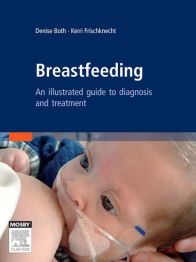Breastfeeding: An illustrated guide to diagnosis and treatment will help lactation consultants, midwives, maternal and child health nurses, medical practitioners and allied health professionals care for breastfeeding mothers and their children. Even after years of practice, health care practitioners will encounter extraordinary situations - and it is precisely then that specific expertise and understanding of breastfeeding issues is critical. Illustrated with over 200 images, this unique resource provides essential information about a vast range of breastfeeding situations: Basic principles of breastfeeding knowledge according to the most recent scientific findings, including breast anatomy and physiology, correct attachment, the milk ejection reflex and breastfeeding positions; Physiological causes of breastfeeding problems such as atypical breast shapes, nipple problems or pathological changes in the breast; Breastfeeding problems associated with the child including prematurity, disability, infection or neurological impairment; and Each full colour image is supported by text providing clear diagnosis and appropriate treatment techniques.
Key Features
- Medically approved equipment for lactation and feeding
- A glossary of medical terms
- An appendix of national and international breastfeeding
- Associations
- A CD containing all images within the text
Author Information
By Denise Both, Chief Editor, Lactation and Breastfeeding, European Association of Lactation Consultants; Breastfeeding and Lactation Consultant in Private Practice and Kerri Frischknecht, Founder of the first lactation program in a Swiss Children's Hospital
1 Basic information about breastfeeding
1.1. The breast before, during and after pregnancy and lactation
1.1.1 Anatomy and physiology of the breast
1.1.2 Adolescence
1.1.3 Young, non-pregnant woman
1.1.4 Pregnant
1.1.5 Before birth
1.1.6 Lactation
1.1.7 Menopause
1.2 Normal course of breastfeeding
1.2.1 Breastfeeding initiation
1.2.2 Sequence of a breastfeed
1.2.3 Let-down reflex (milk ejection reflex)
1.2.4 Infant behavioural cues
1.2.5 Breastfeeding positions
1.3 Breastfeeding multiple infants
1.4 The older breastfed child
1.5 Tandem breastfeeding
1.6 Appearance of breast milk
1.6.1 Colostrum
1.6.2 Transitional milk
1.6.3 Mature breast milk
1.6.4 Blood in breast milk
1.7 Elimination, stool and urine output in the newborn
1.7.1 Meconium
1.7.2 Transitional stools
1.7.3 Breast milk stools
1.7.4 Stools from formula fed infants
1.7.5 Bloody stools
1.7.6 Urine
2 Breastfeeding problems and their causes
2.1 Atypical breast shapes
2.1.1 Asymmetric breasts
2.1.2 Inadequate mammary gland tissue
2.1.2 Accessory mammary gland tissue
2.1.4 Following breast surgery
2.2. Problematic nipple forms
2.2.1 Flat nipples
2.2.2 Retracted/inverted nipples
2.2.3 Small nipples
2.2.4 Large nipples
2.2.5 Bifurcated or double nipples
2.3 Pathological changes of the breast
2.3.1 Mammary gland swelling (initial engorgement)
2.3.2 Local engorgement (plugged ducts)
2.3.3 Mastitis
2.3.4 Abscess
2.3.5 Breast cancer
2.3.6 Nipple cancer (Paget‘s disease of the nipple)
2.4. Pain and injury of the nipple
2.4.1 Sore nipples
2.4.2 Nipple fissures
2.4.3 Candida/thrush
2.4.4 Psoriasis
2.4.5 Allergic reactions
2.4.6 Virus infections – Herpes
2.4.7 Raynaud‘s phenomenon/vasospasm
2.4.8 Milk bleb/milk blisters
2.4.9 Bacterial infections
2.5 Lifestyle
2.5.1 Tattoos
2.5.2 Piercing
2.6 Infants with special needs
2.6.1 Prematurity
2.6.2 Respiratory problems
2.6.3 Reflux
2.6.4 Down syndrome
2.6.5 Neurological impairment
2.6.6 Cephalhaematoma (caput succedaneum)
2.6.7 Failure to thrive
2.6.8 Cleft lip, cleft of the upper alveolar ridge (gum) and palate
2.6.9 Pierre Robin sequence
2.6.10 Choanal atresia and stenosis
2.6.11 Ankyloglossia
2.6.12 Oral candidiasis
2.6.13 Neonatal icterus (jaundice)
2.6.14 Cardiac defects
2.6.15 Chylothorax
2.6.16 Haemangioma
3 Breastfeeding aids and alternative feeding methods
3.1 Aids for expressing human breast milk
3.1.1 Breast pumps
3.1.2 Breast massage
3.1.3 Equipment for transport and storage
3.2 Devices for nipples
3.2.1 Breast shells (A) for inverted nipples
3.2.2 Breast shells (B) for protection
3.2.3 Niplette
3.2.4 Nipple shields
3.3. Alternative feeding methods for the infant
3.3.1 Cup feeding
3.3.2 Soft feeder
3.3.3 Spoon
3.3.4 Pipettev
3.3.5 Supplementary nursing system
3.3.6 Finger feeding
3.3.7 Haberman Feeder (Special Needs Feeder)
3.3.8 Bottle feeding
3.3.9 Pacifiers
3.4 Personal hygiene and clothing
3.4.1 Nursing pads
3.4.2 Temperature packs
3.4.3 Ointments
3.4.4 Nursing bra
Appendix
Glossary
References
Addresses
Websites
Index
Contents
“There is something for everyone in this publication; students, clinicians and educators alike. The CD with power point presentation included on the back cover of the book makes it an absolute winner. Whether your needs are for self-directed learning or classroom teaching, this package is one of the best value education resources I have come across for a long time.
Communique; the official newsletter of the Australian Society of Independent Midwives. Vol 22: 2008
"The information is clearly and concisely written and is fully referenced. Every subject is illustrated by clear, high quality colour photographs."
MIDIRS, June 2009


